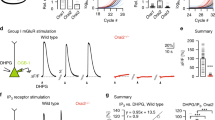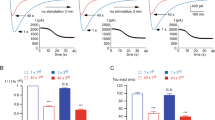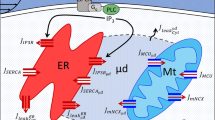Abstract
IN non-excitable cells, release of Ca2+ from the inositol 1,4,5-trisphosphate (InsP3)-sensitive store can activate Ca2+ entry1–3. Very little is known about the signal mechanism relating store emptying to plasma membrane Ca2+ influx. It has been suggested that the signal may be either a diffusible messenger like an inositol phosphate4, or the InsP3 receptor itself, which, by physically coupling to some component of Ca2+ entry in the plasma membrane, may link store release to Ca2+ entry5. The nature of the Ca2+ entry pathway is also unclear. Only in mast cells has a very selective Ca2+ current been observed after store emptying6. Activation of exogenous 5-hydroxytryptamine (5-HT) receptors expressed in Xenopus oocytes or direct injection of InsP3 evokes Ca2+ entry activated by InsP3 pool depletion7. Here we investigate the nature of this influx pathway and find a current activated by pool depletion. This has an unusual selectivity in that it is more permeable to Ca2+ ions than to other divalent cations (Ba2+, Sr2+ or Mn2+ ). Moreover, a K+ permeability is also stimulated after pool depletion. The activation of this store depletion current involves both a phosphatase and an unidentified diffusible messenger. Both the Ca2+ entry pathway and the activating factors found here may be relevant to pool-depleted Ca2+ entry in a variety of non-excitable cells.
This is a preview of subscription content, access via your institution
Access options
Subscribe to this journal
Receive 51 print issues and online access
$199.00 per year
only $3.90 per issue
Buy this article
- Purchase on Springer Link
- Instant access to full article PDF
Prices may be subject to local taxes which are calculated during checkout
Similar content being viewed by others
References
Putney, J. W. Jr Cell Calcium 7, 1–12 (1986).
Berridge, M. J. & Irvine, R. F. Nature 341, 197–205 (1989).
Putney, J. W. Jr et al. FASEB J. 3, 1899–1905 (1989).
Irvine, R. F. Bioessays 13, 419–427 (1991).
Berridge, M. J. Nature 361, 315–325 (1993).
Hoth, M. & Penner, R. Nature 355, 353–355 (1992).
Parekh, A. B., Foguet, M., Lübbert, H. & Stühmer, W. J. Physiol. (in the press).
Parker, I. & Ivorra, I. Science 250, 977–979 (1990).
Lechleiter, J. & Clapham, D. Cell 69, 283–294 (1992).
Lupu-Meiri, M., Beit-Or, A., Christensen, S. B. & Oron, Y. Cell Calcium 14, 101–110 (1993).
Cohen, P. Trends biochem. Sci. 15, 98–102 (1990).
Kramer, R. H. Neuron 2, 335–341 (1990).
Miledi, R. & Parker, I. J. Physiol. 357, 173–183 (1984).
Hoth, M. & Penner, R. J. Physiol. 465, 359–386 (1993).
Sage, S. O., Merritt, J. E., Hallam, T. J. & Rink, T. J. Biochem. J. 258, 923–926 (1989).
Merritt, J. E., Jacob, R. & Hallam, T. J. J. biol. Chem. 253, 1522–1527 (1989).
Mertz, L. M., Baum, B. J. & Ambudkar, I. S. J. biol. Chem. 265, 15010–15014 (1990).
Tinker, A. & Williams, A. J. J. gen. Physiol. 100, 479–493 (1992).
Kume, H., Takai, A., Tokuno, H. & Tomita, T. Nature 341, 152–154 (1989).
Yao, Y. & Parker, I. Proc. R. Soc. Lond. B246, 269–274 (1992).
Vostal, J. G., Jackson W. L. & Shulman, N. R. J. biol. Chem. 266, 16911–16916 (1991).
Foguet, M. et al. EMBO J. 11, 3481–3487 (1992).
Stühmer, W. Meth. Enzym. 207, 319–339 (1992).
Nomura, Y. et al. Molec. Brain Res. 2, 113–123 (1987).
Zodrow, J. & Rogers, S. Life Sci. 34, 1967–1975 (1984).
Lübbert, H. et al. J. Neurosci. 7, 1159–1165 (1987).
Hamill, O., Marty, A., Neher, E., Sakmann, B. & Sigworth, F. Pflügers Arch. 391, 85–100 (1981).
White, M. M. & Aylwin, M. Molec. Pharmac. 37, 720–724 (1990).
Author information
Authors and Affiliations
Rights and permissions
About this article
Cite this article
Parekh, A., Terlau, H. & Stühmer, W. Depletion of InsP3 stores activates a Ca2+ and K+ current by means of a phosphatase and a diffusible messenger. Nature 364, 814–818 (1993). https://doi.org/10.1038/364814a0
Received:
Accepted:
Issue Date:
DOI: https://doi.org/10.1038/364814a0
This article is cited by
-
Functional role of TRPC channels in the regulation of endothelial permeability
Pflügers Archiv - European Journal of Physiology (2005)
-
Store depletion‐induced calcium influx in rat cerebellar astrocytes
British Journal of Pharmacology (2002)
-
Mechanism of store-operated calcium entry
Journal of Biosciences (2000)
-
Bradykinin‐induced phosphoinositide hydrolysis and Ca2+ mobilization in canine cultured tracheal epithelial cells
British Journal of Pharmacology (1999)
Comments
By submitting a comment you agree to abide by our Terms and Community Guidelines. If you find something abusive or that does not comply with our terms or guidelines please flag it as inappropriate.



